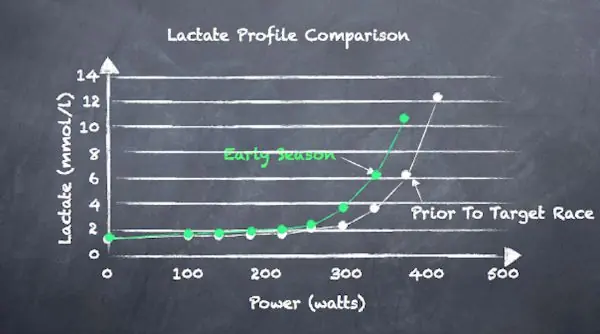How Can An Everyday Cyclist Use An Understanding Of Blood Lactate To Improve Performance?
So how can an everyday cyclist use an understanding of blood lactate to improve performance? Researching blood lactate has given us a great insight into the physiological changes that occur in response to increasing exercise intensity.1) Use training zones as a practical estimate of blood lactate response
When we design a training program, we are trying to plan intensities and durations of riding that will result in the physiological responses we need to create the adaptations we are looking for.
Blood lactate measurements provide a means to predict what physiological responses are taking place, but even if we don't have access to blood lactate measurement, we can use training zones to make pretty good guesses about what's going on in our cells.
More: 7 Strength and Mobility Exercises for Cyclists
There are many methods to establish training zones, but typically riders will conduct an all out effort of between 20-60 minutes and establish zones based on a percentage of the results. Once you've done this, you can use the zones to target particular energy systems and the adaptations you need to achieve your cycling goals. If you've never established your training zones, make it a priority before your next training block.

2) Test yourself regularly to chart changes in performance
Observing changes in blood lactate response to exercise can help us understand if a rider is improving (or not). As a rider gets fitter, we'd expect to see a shift in the rider's blood lactate curve.
The lactate curve is a graph which describes blood lactate concentration relative to exercise intensity, usually in response to a ramp test. A right shift in the curve would indicate that the rider was producing less lactate for a given intensity, suggesting adaptations had taken place at a cellular level. Effectively, the body is becoming better at liberating energy for the muscle contractions which turn the pedals.
It's relatively easy to conduct tests on yourself to see if your performance is changing – you just need a way of measuring the output – are you getting better at turning the pedals! Set up your bike on a turbo-trainer with a bike computer which measures speed and distance and use power meter (if you have one).
More: What Does 8,000 Calories Look Like?
Attempt your best efforts over 5 seconds, 1 minute, 5 minutes and 20 minutes (you may need to do them on different days). You could use many of the popular software packages, websites, or even set up a simple spreadsheet to record the average power (or distance covered if you don't have a power meter) for each time period.

Retest yourself at regular intervals through the season and see if you're results are improving. If you're getting better, your average power and distance covered should increase. If it's not, try to adjust your training to address the time period which is lagging: if your 5 second tests are lagging behind, try adding in some more sprint sessions. If your 20 minute power is disproportionately low, perhaps you need some more volume.
3) Include high-intensity intervals in your training
We now know that blood lactate can send 'signals' resulting in many beneficial adaptations for cycling performance – it's one of the reasons that high-intensity intervals can be so effective. Aim to progress to the point that you can accumulate around 18 minutes of work at a minimum of 106% of your FTP (95% of your best 20 minute power), or greater than 89% of your maximum heart rate, if you don't have a power meter.
As long as the interval intensity is at least 106%, experiment with varying work periods and recovery between intervals. As a starting point, see how many 3 minute intervals you can complete at 120% of FTP, with 3 minutes recovery in-between.
Lactic Acid Is Your Friend!
Hopefully this article has helped to dispel some of the myths around blood lactate and provided some useful pointers to inform your training. If you only take away one thing, remember this: lactic acid is your friend!
More: 3 Common Racing Mistakes
 Ready to Ride? Search for a cycling event.
Ready to Ride? Search for a cycling event.


